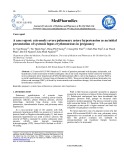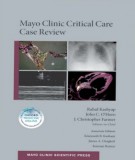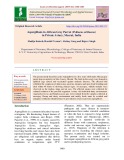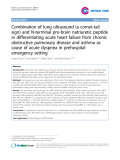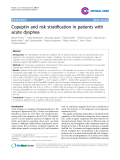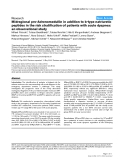
Acute dyspnea
-
A 33-year-old G2 P1001 female at 13 weeks of gestation presented with dyspnea, tachycardia, and hypotension. Initial assessment revealed cardiogenic shock and acute respiratory failure caused by extremely severe pulmonary artery hypertension (PAH).
 7p
7p  vikissinger
vikissinger
 21-12-2023
21-12-2023
 1
1
 1
1
 Download
Download
-
To examine risk factors for asthma patients’ emergency room (ER) visits in a well organized asthma care setting. Methods: A random sample of 344 asthma patients from a Pulmonary Clinic of a University Hospital were followed through medical records from 1995 to 2006. All the ER visits due to dyspnea, respiratory infections, chest pain, and discomfort were evaluated.
 9p
9p  vimontana2711
vimontana2711
 05-04-2021
05-04-2021
 10
10
 1
1
 Download
Download
-
In this part 1 of ebook "Mayo clinic critical care case review", you will learn to: Dyspnea and edema, an electrical problem, hypertension, a rare cause of liver failure, shortness of breath, acute respiratory failure in a young smoker, shock, diffuse abdominal pain in a 45-year-old woman, an over-the-counter intoxication, an over-the-counter overdose,...
 133p
133p  nanhankhuoctai5
nanhankhuoctai5
 01-06-2020
01-06-2020
 8
8
 2
2
 Download
Download
-
The present study describes acute Aspergillosis in a five years old female African grey parrot kept in captivity in Meo Aviary, Meerut. The birds in the aviary were housed in uplifted cage system and vaccinated against endemic diseases. The affected bird exhibited the symptoms of depression, anorexia, dyspnea and open beak breathing and died within 48 hours of showing clinical signs. At necropsy, whitish nodules were observed on the trachea, lungs and air sacs. The affected organs were collected for cultural isolation of the possible organism. Aviary visit indicated dusty environment.
 4p
4p  cothumenhmong1
cothumenhmong1
 08-12-2019
08-12-2019
 8
8
 0
0
 Download
Download
-
(BQ) Continued part 1, part 2 of the document Handbook for intensivists about echocardiography has contents: Intraoperative echocardiography in cardiac surgery, general hemodynamic assessment, hypovolemia and fluid responsiveness, suspicion of pulmonary embolism, chest pain, acute dyspnea, unexplained hypoxemia,.... and other ocntents. Invite you to refer.
 195p
195p  thuongdanguyetan05
thuongdanguyetan05
 05-07-2019
05-07-2019
 8
8
 1
1
 Download
Download
-
Tuyển tập các báo cáo nghiên cứu về y học được đăng trên tạp chí y học Critical Care giúp cho các bạn có thêm kiến thức về ngành y học đề tài: Combination of lung ultrasound (a comet-tail sign) and N-terminal pro-brain natriuretic peptide in differentiating acute heart failure from chronic obstructive pulmonary disease and asthma as cause of acute dyspnea in prehospital emergency setting...
 9p
9p  coxanh_8
coxanh_8
 05-11-2011
05-11-2011
 43
43
 1
1
 Download
Download
-
Tuyển tập các báo cáo nghiên cứu về y học được đăng trên tạp chí y học Critical Care giúp cho các bạn có thêm kiến thức về ngành y học đề tài: Copeptin and risk stratification in patients with acute dyspnea...
 9p
9p  thulanh18
thulanh18
 05-11-2011
05-11-2011
 54
54
 1
1
 Download
Download
-
Tuyển tập các báo cáo nghiên cứu về y học được đăng trên tạp chí y học Critical Care giúp cho các bạn có thêm kiến thức về ngành y học đề tài: Midregional pro-Adrenomedullin in addition to b-type natriuretic peptides in the risk stratification of patients with acute dyspnea: an observational study...
 11p
11p  coxanh_6
coxanh_6
 29-10-2011
29-10-2011
 52
52
 1
1
 Download
Download
-
Treatment of Promyelocytic Leukemia Tretinoin is an oral drug that induces the differentiation of leukemic cells bearing the t(15;17). APL is responsive to cytarabine and daunorubicin, but about 10% of patients treated with these drugs die from DIC induced by the release of granule components by dying tumor cells. Tretinoin does not produce DIC but produces another complication called the retinoic acid syndrome. Occurring within the first 3 weeks of treatment, it is characterized by fever, dyspnea, chest pain, pulmonary infiltrates, pleural and pericardial effusions, and hypoxia.
 5p
5p  thanhongan
thanhongan
 07-12-2010
07-12-2010
 58
58
 2
2
 Download
Download
-
Approach to the Patient: Hemoptysis The history is extremely valuable. Hemoptysis that is described as bloodstreaking of mucopurulent or purulent sputum often suggests bronchitis. Chronic production of sputum with a recent change in quantity or appearance favors an acute exacerbation of chronic bronchitis. Fever or chills accompanying bloodstreaked purulent sputum suggests pneumonia, whereas a putrid smell to the sputum raises the possibility of lung abscess. When sputum production has been chronic and copious, the diagnosis of bronchiectasis should be considered.
 7p
7p  ongxaemnumber1
ongxaemnumber1
 29-11-2010
29-11-2010
 69
69
 4
4
 Download
Download
-
Approach to the Patient: Dyspnea (Fig. 33-3) In obtaining a history, the patient should be asked to describe in his/her own words what the discomfort feels like, as well as the effect of position, infections, and environmental stimuli on the dyspnea. Orthopnea is a common indicator of congestive heart failure, mechanical impairment of the diaphragm associated with obesity, or asthma triggered by esophageal reflux. Nocturnal dyspnea suggests congestive heart failure or asthma.
 5p
5p  ongxaemnumber1
ongxaemnumber1
 29-11-2010
29-11-2010
 54
54
 4
4
 Download
Download
-
Differential Diagnosis Dyspnea is the consequence of deviations from normal function in the cardiopulmonary systems. Alterations in the respiratory system can be considered in the context of the controller (stimulation of breathing); the ventilatory pump (the bones and muscles that form the chest wall, the airways, and the pleura); and the gas exchanger (the alveoli, pulmonary vasculature, and surrounding lung parenchyma). Similarly, alterations in the cardiovascular system can be grouped into three categories: conditions associated with high, normal, and low cardiac output (Fig. 33-2).
 5p
5p  ongxaemnumber1
ongxaemnumber1
 29-11-2010
29-11-2010
 74
74
 2
2
 Download
Download
-
Integration: Efferent-Reafferent Mismatch A discrepancy or mismatch between the feed-forward message to the ventilatory muscles and the feedback from receptors that monitor the response of the ventilatory pump increases the intensity of dyspnea. This is particularly important when there is a mechanical derangement of the ventilatory pump, such as in asthma or chronic obstructive pulmonary disease (COPD).
 5p
5p  ongxaemnumber1
ongxaemnumber1
 29-11-2010
29-11-2010
 48
48
 3
3
 Download
Download
-
Pulmonary Embolism (See also Chap. 256) Chest pain due to pulmonary embolism is believed to be due to distention of the pulmonary artery or infarction of a segment of the lung adjacent to the pleura. Massive pulmonary emboli may lead to substernal pain that is suggestive of acute myocardial infarction. More commonly, smaller emboli lead to focal pulmonary infarctions that cause pain that is lateral and pleuritic. Associated symptoms include dyspnea and, occasionally, hemoptysis. Tachycardia is usually present.
 5p
5p  ongxaemnumber1
ongxaemnumber1
 26-11-2010
26-11-2010
 66
66
 2
2
 Download
Download
-
Unstable Angina and Myocardial Infarction (See also Chaps. 238 and 239) Patients with these acute ischemic syndromes usually complain of symptoms similar in quality to angina pectoris, but more prolonged and severe. The onset of these syndromes may occur with the patient at rest, or awakened from sleep, and sublingual nitroglycerin may lead to transient or no relief. Accompanying symptoms may include diaphoresis, dyspnea, nausea, and light-headedness. The physical examination may be completely normal in patients with chest discomfort due to ischemic heart disease.
 5p
5p  ongxaemnumber1
ongxaemnumber1
 26-11-2010
26-11-2010
 62
62
 3
3
 Download
Download
-
Angina Pectoris (See also Chap. 237) The chest discomfort of myocardial ischemia is a visceral discomfort that is usually described as a heaviness, pressure, or squeezing (Table 13-2). Other common adjectives for anginal pain are burning and aching. Some patients deny any "pain" but may admit to dyspnea or a vague sense of anxiety. The word "sharp" is sometimes used by patients to describe intensity rather than quality.
 9p
9p  ongxaemnumber1
ongxaemnumber1
 26-11-2010
26-11-2010
 64
64
 3
3
 Download
Download
CHỦ ĐỀ BẠN MUỐN TÌM








